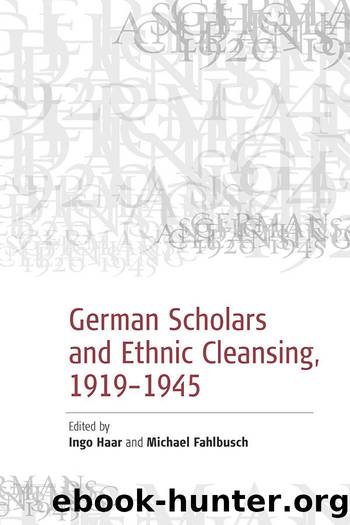German Scholars and Ethnic Cleansing, 1919-1945 by Michael Fahlbusch Ingo Haar

Author:Michael Fahlbusch, Ingo Haar [Michael Fahlbusch, Ingo Haar]
Language: eng
Format: epub
ISBN: 9780857457059
Barnesnoble:
Publisher: Berghahn Books, Incorporated
Published: 2005-01-01T00:00:00+00:00
Sabin ManuilÄâs Collaboration with German Scholars
ManuilÄâs wartime contacts with a number of German scholars should not be viewed from the sole perspective of his competence and interest in demography and ethnopolitics, but also from that of the special position the Central Institute of Statistics held in Romania at the time. Romania had no structure that could compareâin terms of organization, personnel, and so onâto Germanyâs vast network of bodies and institutions that were responsible for population policy. As was mentioned earlier, the idea of an ethnopolitical approach did not emerge in Romania until 1940. Aside from being Romaniaâs chief expert in ethnopolitics, ManuilÄ had gathered at the institute almost all of the handful of other scholars who dealt or were beginning to deal with the issue. The ICS Office for Studies, which in 1941 hired many young researchers from the disbanded, well-known Romanian Social Institute (headed by Dimitrie Gusti), worked extensively on ethnopolitics. ManuilÄâs chief co-worker, Anton Golopenia, served as director of the office.
An interest in ethnopolitics also developed at the Ministry of Foreign Affairs, where a number of projects targeting specific regions or population groups (i.e., minority groups in Romania or ethnic Romanian groups in neighboring countries) were elaborated. These projects, which were actually built on ethnodemographic and other ICS-supplied data, worked out various aspects of the overall policy, such as international justifications for the planned population transfers.
Still, the ICS was the main center for ethnopolitical studies and the only one to which the Germans and other foreigners were given access. The institute employed various experts whose activities ranged from thorough scientific studies to development of propaganda material in diverse areasâ statistics, demography, economics, history, geography, etc. Given this vast array of tasks, which in Germany were carried out by many different entities, the institute was an attractive resource to anybody who took interest in Romania.
Of course, the ICS was not the sole Romanian institution taken into consideration by German scientists. They and their institutions had contacts in the Romanian universities, the Romanian Academy, and other institutes. The Deutsches Wissenschaftliches Institut (German Cultural Institute) in Bucharest, headed by the romanist Ernst Gamillscheg (a member of the Westdeutsche Forschungsgemeinschaft or West German Research Society) was very active in promoting German-Romanian scientific contacts. Also, the research institutes of the German Ethnic Group in Romania (Deutsche Volksgruppe in Rumänien) were subordinated to the Southeast German Society in Vienna. But for the interests in the field of ethnopolitics, the ICS was the most important.14
Evidence of ManuilÄâs contacts with the Germans can now be found in but a few documents, as very little of the ICS archive for 1940â1944 is still available. This particular archive was destroyed in 1948/49 to wipe out the traces not only of the census but also of a sociological survey of the Romanians living east of the Dniester and Bug rivers in the Soviet Union. An ICS team headed by Golopenia had conducted the survey in 1942/43, when the Romanian government was laying the groundwork for the repatriation of those communities.
Download
This site does not store any files on its server. We only index and link to content provided by other sites. Please contact the content providers to delete copyright contents if any and email us, we'll remove relevant links or contents immediately.
Room 212 by Kate Stewart(5035)
The Crown by Robert Lacey(4723)
Endurance: Shackleton's Incredible Voyage by Alfred Lansing(4676)
The Iron Duke by The Iron Duke(4291)
The Rape of Nanking by Iris Chang(4137)
Joan of Arc by Mary Gordon(4013)
Killing England by Bill O'Reilly(3951)
Say Nothing by Patrick Radden Keefe(3903)
I'll Give You the Sun by Jandy Nelson(3358)
Shadow of Night by Deborah Harkness(3302)
Hitler's Monsters by Eric Kurlander(3268)
Mary, Queen of Scots, and the Murder of Lord Darnley by Alison Weir(3149)
Blood and Sand by Alex Von Tunzelmann(3138)
Darkest Hour by Anthony McCarten(3070)
Eleanor & Park by Rainbow Rowell(3063)
Margaret Thatcher: The Autobiography by Thatcher Margaret(3028)
Red Famine: Stalin's War on Ukraine by Anne Applebaum(2873)
Book of Life by Deborah Harkness(2867)
The One Memory of Flora Banks by Emily Barr(2803)
